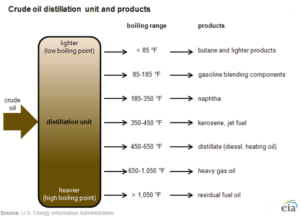What is Crude Oil and Where is it Found?
When we release an oil check, it’s usually a response to a potentially market disrupting event. Natural disaster or armed conflict, we share speculations on the repercussions. Specifically, how they could impact both your company and employees’ fuel expenses. This oil check is a little different. Because, believe it or not, every crude oil is a little different. So we’re going to break down the major classifications of crude oil, how they impact the production process and where they’re found.
The Varieties of Crude Oil
First things first. Oil derricks, oil rigs, oil wells, they’re all pumping liquid petroleum, which is commonly referred to as crude oil. If you want to get all chemical, it’s a lot of carbon, a little hydrogen, and pinches of oxygen, sulfur, nitrogen and helium. Each crude is classified by the following values: sweet, sour, light, heavy and toxicity.
Sweet Crude and Sour Crude
If your first thought is “Did they?” the answer is yes, they did. Back in the day, oil prospectors would taste the oil to determine the quality of their new-found riches. We’ve come a long way since those days, but the classification remains.
The less sulfur a crude oil has, the sweeter it is. If it’s found to have more sulfur, well, then you have a “sour” crude. If a crude oil is found to have more sulfur, it will require more processing effort to produce a quality product, whether that’s gasoline or a plastic.
Light Crude and Heavy Crude
Remember the science experiment where you put oil and water in the same glass and the oil would float to the top? No? Maybe you’ve looked at a salad dressing and seen the multiple layers of a vinaigrette? Either way, the lesson is a simple one: some oils have less density than water. And that’s another way to determine crude oil quality.
A lighter oil, as qualified by the American Petroleum Institute, is preferred because it’s easier to refine and thus cost less to produce. Heavy crude has a whole bunch of metals in it that makes it more difficult to refine into fuel. Even distilled, it’s only capable of making lower-valued products. To get a heavy crude to the same level as light crude requires a lot more refinement.
Toxicity
Oil spills. Oil slicks. Exhaust fumes. Plastic bags in the ocean. Crude doesn’t play well with the rest of the planet. In fact, its toxicity is another categorization that requires handlers be extra careful when running it through the refinement process and beyond. The scale runs from Class A to Class D, Class A being the most harmful to humans and other life, Class D being the least. Keep in mind, Class D is still very toxic. No being should be drinking crude oil in any form to get a jump start for their day.
The Distillation Process
All crude goes through the distillation process to different degrees. You can’t just put crude oil into a cigarette lighter or the tank of your car. To produce any petroleum product, the crude oil goes through a processing/refinement process. The result? Depending on the heat, gasoline, jet fuel, diesel and whatever residuals the process produced. Generally, the lighter the crude, the less byproduct. Less byproduct, less waste. This is the main reason lighter crude has such high value.
The Most Common Crude Oils and Where to Find Them
In the world of soft drinks, it’s Coca-cola versus Pepsi. In the world of oil, things are a little different. Here are some of the more well-known crude oils.
West Texas Intermediate (WTI)
This is a light, sweet crude, often refined in the Midwest and Gulf Coast regions. As it is both less dense and has a lower sulfur content, the U.S. generally uses WTI when benchmarking the crude of other states (Oklahoma, Montana, the Dakotas, etc). This crude is primarily used to create gasoline, kerosene and diesel.
Brent Crude
Also a light, sweet crude, Brent is specific to oilfields of the North Sea and includes a number of varieties such as Brent Blend, Forties blend, Oesberg and Ekofisk. Due to its desirable makeup and popularity, Brent is generally used to benchmark oil prices globally. Again, this crude is primarily for gasoline, kerosene and diesel.
Dubai Crude
This crude is medium sour, with a higher sulfur content and gravity. Like the previous two types, Dubai Crude, also known as Fateh, is used as a benchmark, specifically for oil in the Persian Gulf. While it can be processed into a variety of byproducts, including fuel, this process requires more refinement, so it isn’t as highly demanded as its lighter counterparts.
What All This Means For You
While it’s hard to attribute increased oil prices to an incident in a region, it’s much easier to see what type of crude production is impacted and how that, in turn, will impact prices. The crudes listed above are well known, but they are far from the only types produced around the world. There are at least as many oil products as there are oil reserves. The quality of crude, geography of the reserve, country controlling the region and the company extracting it all influence how it reaches the market, how likely the production is to continue and how much danger the process poses the environment.
To stay up to date on the state of crude and how it impacts fuel prices, subscribe to our blog and keep an eye out for the next Oil Check!








